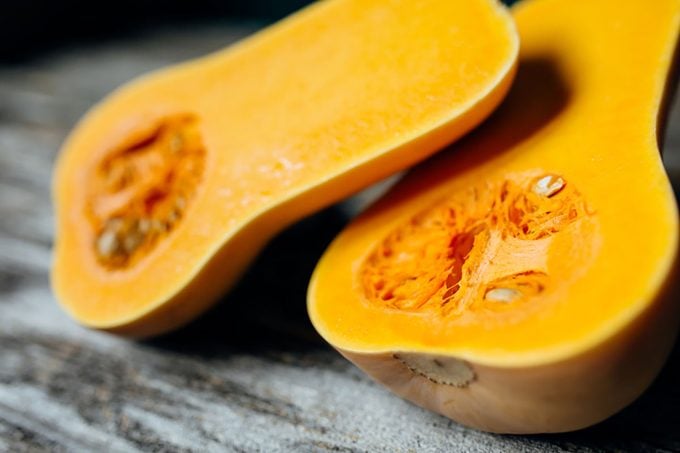How to Pick the Best Butternut Squash (That’s Perfectly Ripe!)
Updated: Aug. 25, 2022
Our tips on what to look for when choosing the perfect butternut squash for your fall cooking.

There’s so much to love about fresh fall produce. It’s more than just pumpkin spice everything. It’s also all the delicious seasonal squashes—acorn, spaghetti and, most importantly, butternut. Get our best slow cooker squash recipes here!
Butternut squash is an essential ingredient for crisp autumn days. It’s a big player in comforting soups, stews and sautes. But finding the right one can be difficult. If it’s underripe, the squash won’t have developed its signature taste. If it’s overripe, it may be dry, mushy or flavorless. Follow these tips the next time you’re at the grocery store or farmers market to find the perfect recipe-ready butternut squash.
Consider the Weight
Pick it up to feel its weight. A ripe butternut squash should be hard and heavy for its size. What exactly does that mean? Use your best judgment and pick up other squashes to get an idea of the average weight. If a squash is too light, it’s not ripe enough yet. You can also do the tried-and-true knocking test. Tap the outside of the vegetable. If it sounds hollow, it’s ready to eat.
Already at the grocery store? Learn how to shop like a boss.
Look at the Stem
You want a butternut squash with a full stem that’s firm to the touch. When the stem is intact, your squash will keep longer. If the stem is missing, it may have popped out because the squash is past its prime. Look at the color of the stem, too. The perfect hue? Deep brown.
Learn how to store apples so they last all season long.
Examine the Skin Color
The deeper the hue, the better. A butternut squash should be dark beige. Green spots or streaks mean the squash isn’t fully ripened. But that pale spot you might see? That’s OK—it’s just where the squash was lying on the ground in the field.
There’s a trick to choosing the best pumpkin, too.
Inspect the Skin
Ideally, your butternut squash will not be shiny or waxy (a sign it was picked too early). Look for one with a matte finish, with color that’s even across the entire surface. The thickness of the shell is equally important. Use your fingernail to try to gently prick the surface. If your nail goes through easily, it’s not a good squash. You want one with a hard exterior.
Psst! Here’s why you should never, ever shake an apple tree.
Avoid Certain Characteristics
Now you know how to assess a butternut squash’s weight, color and texture—but don’t stop there. Stay away from any squashes with obvious cuts or soft spots that might lead to rot or mold. Brown marks, usually caused by frost, are a sign the squash won’t last as long or will have an undesirable texture.
Have squash you need to use fast? Try one of our favorites: Butternut Squash Apple Bake.
Keep these tips in mind and you’ll find a butternut squash that’s ready for dinner tonight. And remember, if you’re at a farmers market and still unsure about your squash, ask the farmer! (They know best, after all.)
Ready to start cooking your perfect butternut squash? You have a world (or, well, a kitchen) of opportunity, from savory soups to delicious desserts to creamy casseroles. Ah…fall is in the air!
